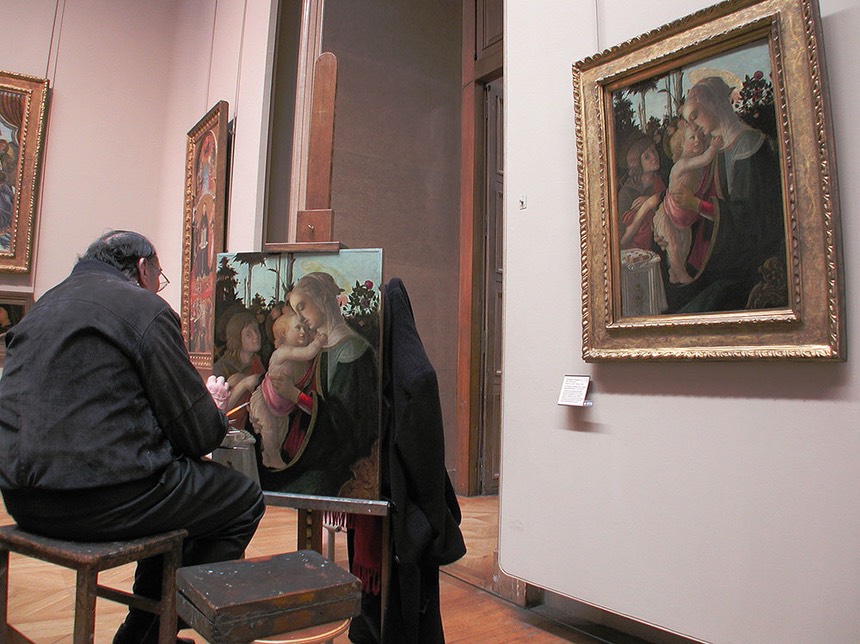
There’s long been a heated discussion about photography and where it fits into the worldview in the liberal arts. Is it a craft, or is it art? Recently I had someone vehemently argue that I’d never possibly be considered an artist, no matter what I did in terms of my photography.
As the image above suggests, there might be components of both going on. To a large degree, to become an artist you tend to have mastered your craft. That doesn’t have to be literal, as it is in the case shown here, but it’s more a left-brain, right-brain type of thing. You have to learn to control your abilities (craft) before you can freely use them (art).
In painting, it helps to know about colors, brushes, ink types, canvas, and more (craft) and using those things coupled with known techniques creatively and uniquely is what creates art.
Of course, dictionaries can’t even agree on what the term art means:
- Something that is created with imagination and skill and that is beautiful or that expresses important ideas or feelings [Merriam-Webster]
- The quality, production, expression, or realm, according to aesthetic principles, of what is beautiful, appealing, or of more than ordinary significance [dictionary.com]
- The expression or application of human creative skill and imagination…producing works to be appreciated primarily for their beauty or emotional power [google]
And note how many words within those definitions contain potentially arguable words (beauty, feeling, expression, aesthetic, appealing, emotional power).
Having been a professional musician, writer, filmmaker, and photographer, and having a mother who’s a painter and sculptor, I’ve personally adapted a fairly simplistic approach to the craft/art debate: craft is the techniques you learn and the practice you do with those, art is what you make of your craft when you’re not practicing.
Thus, exposure, focus, demosaicing, and a whole host of other things are part of the craft side of photography. Can you set exposure consistently? Do you even know what exposure is and what the components of it are? If not, then creating something uniquely yours photographically starts to become a random walk. Indeed, back in the film days, mastering exposure was actually a long process for most people, and any new film emulsion often led to having to remaster it. Velvia, for example, has a very steep drop to black about three stops under middle gray. Very steep. Indeed, it was one of the few slide films that could truly create a real black in projection of “well exposed” images.
When Velvia first came out, I remember that there was a rush of experimentation amongst serious photographers. Which produced some interesting results. Some pros thought Velvia should be exposed at ISO 40, others at ISO 64, for example. Were either of these groups wrong? No. Their decisions were driven by a lot of craft work trying to ascertain what happened when they applied their already established exposure decision making to the new emulsion, then adjusting until they got repeatable results they liked.
Which brings up an important aspect that a lot of people don’t appreciate: there can be differences in craft. I actually hate it when someone I don’t know asks me “what’s the exposure?” Why? Because I have no idea if they think of exposure and practice it the same way I do. We have a similar example to Velvia with digital these days: some folk use ETTR (Expose To The Right), others use ETTR but ignore specular highlights, others use some sort of quasi-Zone System, while still others believe that "middle gray" should always be exactly a pixel value that’s in the middle. (Note the quotes around “middle gray,” as there are still other subsets that have different definitions of what that means.)
So even craft isn’t so straight forward. We have a lot of variables we juggle in photography, and all of them need you to build skill sets in order to maximize their use.
I had a discussion yesterday with my assistant about focus technique, for example. When I pointed out something I considered sub-optimal in some personal images he was showing me, it actually led to a craft discussion and I discovered that something I do all the time I’ve never really taught him to do. The exact situation involved an animal in what my assistant knew would be a constrained space (and thus, firmly established distance from him). For example, if you go to a zoo, the lion can only get so close and so far from you: he’s constrained. That happens in the real world, too, as an elephant can’t climb a cliff and lions will tend to try to walk around water if possible.
Understanding constraint is actually good to know when it comes to focus. Too many people rely totally on the autofocus system to get the right focus. Then they complain about things like the autofocus sensors being too small (or too big) or not being able to put an autofocus sensor on the thing they want it on unless they compromise their composition, and so on. But wait a minute. If the animal is going to be a maximum of 15 feet from you and a minimum of 10 feet, couldn’t you just perform an autofocus and then manually focus when the animal moves by doing some practice ahead of time?
Or this: the animal is currently facing you and standing on a rock and very likely to come off that rock towards you. Which way do you turn the focus ring as the animal jumps? And how fast?
Those are practicable, learnable things; techniques. The craft part of the equation. The more of those craft tools you’ve mastered, the more it frees you to think about the art side of the equation: why am I taking this photo and what am I trying to convey with it?
